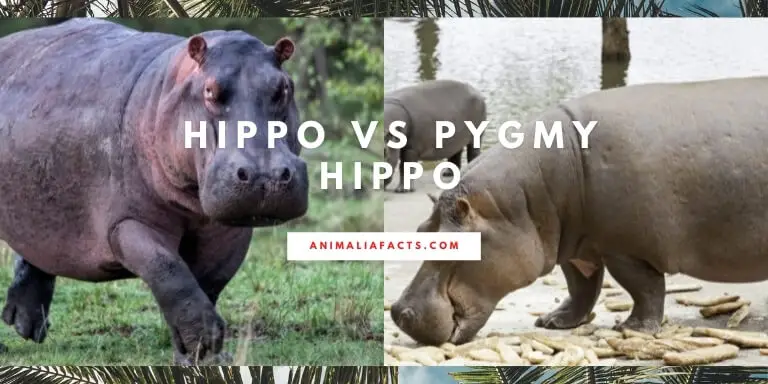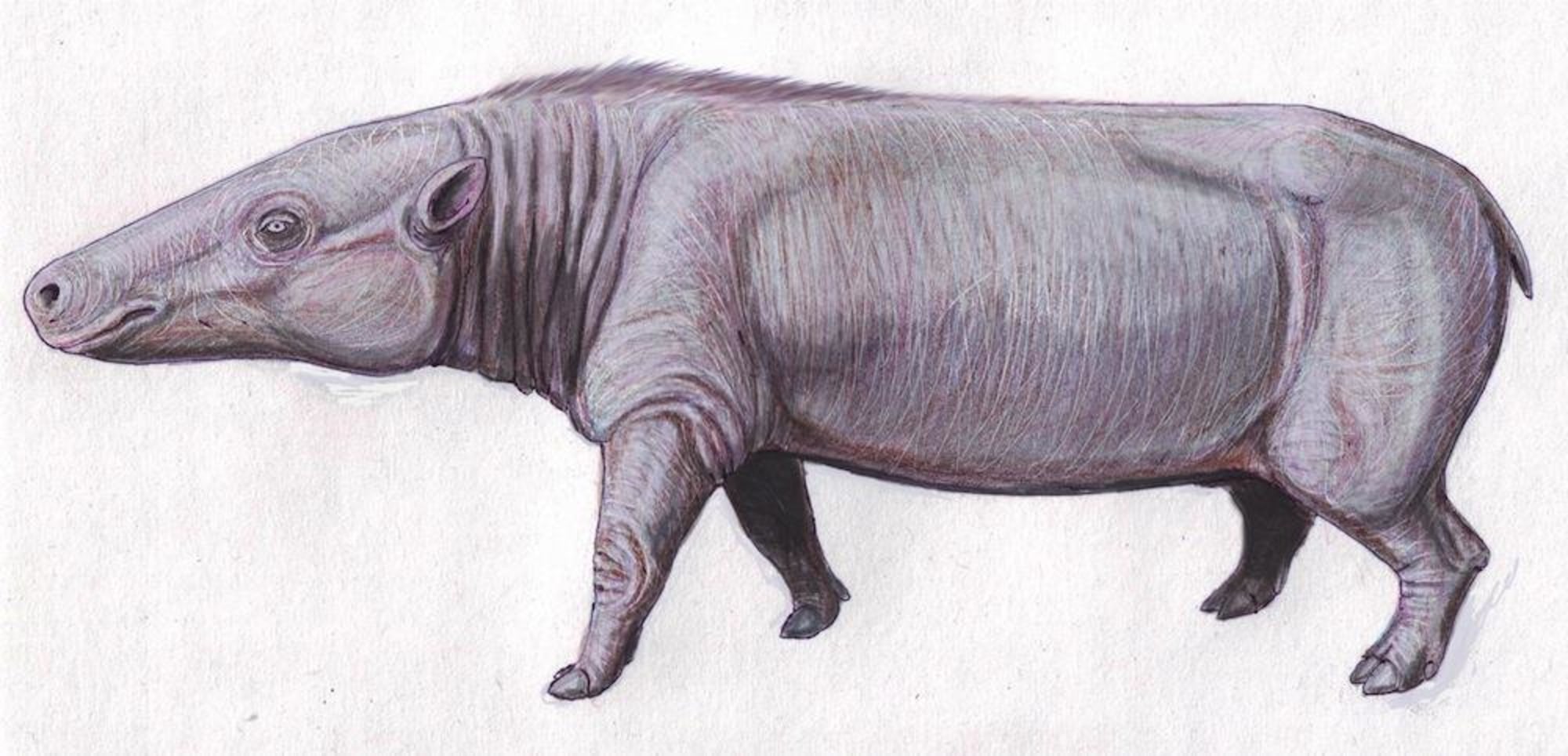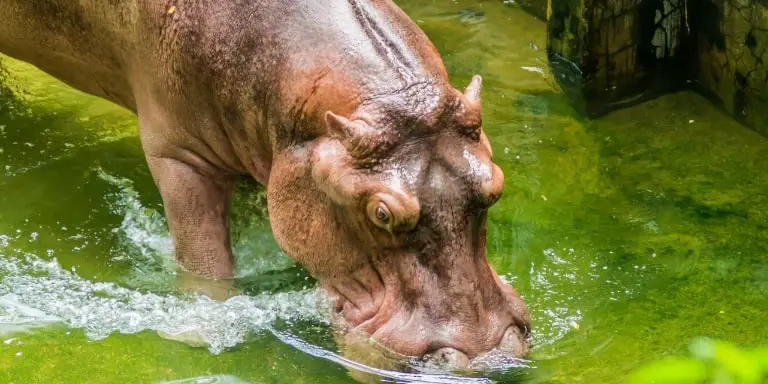The hippopotamus has got a shy cousin from the west. Pygmy hippos are native to West Africa. They are a miniature version of the bigger hippos. Living deep in the rainforests of Sub-Saharan Africa, these dwarfs are highly antisocial.
The tiny animals are rarely spotted in their natural habitat. But surprisingly the river hippos that are considered “regular” originally evolved from their tiny cousins. Pygmy hippo vs regular hippo comparison is gaining interest among wildlife enthusiasts.

Pygmy Vs Common Hippo – Comparison Chart
| Compared by | Pygmy Hippo | Regular Hippo |
|---|---|---|
| Scientific Name | Choeropsis liberiensis | Hippopotamus amphibius |
| Size | Size Small animals. Heads are smaller compared to the body. Giant animals. Heads are bigger compared to their bodies. | Giant animals. Heads are bigger compared to their bodies. |
| Weight | Weight Carries a weight of around 280 kilograms. | Can weigh from 1400 to 4000 kilograms. That is about half the weight of an African elephant! |
| Speed | About 18 to 19 mph | About 29 mph |
| Diet | Herbivorous | Herbivorous. Can eat up to 25 to 40 kg vegetables every day. |
| Bite Force | Has a surprising bite force of about 1800 pounds per square inch. | Has a bite force of 2000 pounds per square inch. |
| Skin | Has thin skin to keep their bodies humid. | Has very fat skin which acts as a protection from predators. |
| Behavior | Antisocial in nature. Avoids contact & never attacks. | Lives in big groups by the river banks. Might attack if provoked. |
| Hostility | Aren’t hostile at all. Avoids being in a fuss. | Very aggressive & extremely territorial creatures. |
| Reproduction | A single calf is born after a period of 5 to 7 months. Can easily reproduce in the zoo. | A single calf is born after about 8 months. Has difficulties reproducing in captivity. |
| Lifespan | Around 30 to 50 years in captivity. | Up to 50 years in the wild. |
| Habitat | Rainforests of West Africa | Shallow rivers or canals all over Africa |
| Population | Only around 3000 pygmies are left in the wild. | About 150,000 ginormous beasts are roaming on the river banks of Sub-Saharan Africa. |
| Predators | Hunted by Leopards. Also, have to watch their backs from the crocodiles in the water. | Aren’t intimidated by any predator on land. Can easily coexist with crocodiles. |
| Conservation Status | Endangered | Vulnerable |
Hippopotamus Ancestors
Hippo ancestry has taken a new dimension with the very recent discovery in Kenya. The rock beds in Kenya were dug to find out a fossil that is believed to be the closest ancestors to hippos. The overgrown sheep figure is considered the great-great-grandfather of both the giant & the dwarf hippos. The closest living relative of a hippo is whales & dolphins. Pigs are not related to them.

Five Physical Difference – Pygmy Hippo VS Regular Hippo
Size & weight
A regular adult hippopotamus can easily surpass the head of a 6 feet tall man. The giant bulls can weigh up to 4000 kilograms & the cows up to 1400 kilograms.
The pygmy hippo can hardly touch the limit of 5 feet. The shy tiny cousins weigh less than ¼ of a common hippo with only 280 kilograms to carry.
Body
Giant hippopotami have eyes & nostrils situated on top of the head so they can easily breathe from underwater without coming out. They have tough legs with dense toes. Their bodies normally have a length of 10 to 14 feet.
Pygmy hippos have lighter legs with longer toes compared to their bodies. They can move swiftly through the wet soiled rain forests. The body length of the dwarfs is about 6 feet.
Skin
Both the beasts have reddish skin. Both of their skins ooze out a reddish sweat which acts combinedly as sunscreen & antibacterial liquid. Regular hippopotamuses have very tough skin that protects them from predator attacks.
Pygmies have thin skin that keeps them cool in the humid weather of the rainforests.
Mouth
The bigger hippos have a bigger head & the smaller ones have a smaller head compared to their bodies. The river hippopotami’s massive canines can grow up to 20 inches long. The enormous ones can open their mouth to 180 degrees.
Pygmies have lesser long canines & a single pair of incisors. The small cousins have a massive gape with a bit short of 150 degrees.
Speed
Common Hippos can run up to 29 mph (45 km/h) on foot. (That is about the top speed of Usain Bolt!) In the wild, they’re generally found running at around 20 mph. They can also torpedo through the water at a speed up to 5 mph.
The small ones have a speed of about 18 to 19 mph (29 km/h). Through the dense inaccessible forests of West Africa, the animals can move swiftly even with their hefty figure.
Hostile Behavior of Hippopotamuses

Regular size beasts can be dangerous to humans. They are territorial beings & dislike being startled. They are hardly intimidated. Most of the day they spend being submerged in the shallow rivers & canals of Africa. They live in large groups of twenty or more. They’re considered the most dangerous animal in Africa.
Pygmy hippos are antisocial beings. They roam singly or in small groups such as mating couple or as mother & calf. They are territorial & may present warning signs (like yawning) if intimidated. Normally they just avoid being in a fuss & flee. During the day they’re found in the waters of the rainforests to keep themselves cool.

Habitat
Shallow rivers with small grass & vegetation on the land are the dream home for common hippos. It is estimated that around 150,000 giants are roaming the lands of Africa.
Swamps of West Africa are the ideal habitat for pygmy hippopotamuses. Most of its population is distributed in Liberia, Sierra Leone, Guinea, and the Ivory Coast have a small proportion. The miniature amphibians like to have families in burrows near swamp water. Only 3000 pygmies are considered to be left in the wild.
Diet
Both the common & the pygmy hippopotami are entirely dependant on vegetation near rivers & swamps. Every day they eat about 1% to 1.5% of their body weight. Tender small grass is the first choice of the regular size vegans. After dusk, they start grazing in search of food & occasionally are found 5 to 6 miles away from their rivers. They are herbivorous beasts & pretty much like to eat anything green.
The introverted cousins have a better choice in food. Their everyday diet includes small grass, tender leaves, berries, roots, and whatever vegetation they can find in the forests. After bathing for 5 to 6 hours in the morning, they start looking for food after sunset.
Lifespan
Bigger hippopotamuses tend to live longer. They have an average life expectancy of 50 years in the wild. Their longevity extends in captivity. The longest living hippo exceeded 61 years (in a zoo).
Pygmy hippopotamus longevity in the wild is unsure. They live a life of about 30 to 50 years (in captivity).
Survival of Hippo Families

Common hippos are polygamous. They start mating when they’re 7 or 8 years old. They mate in the water & give birth in the water. The single calf is born after a gestation period of about 8 months. The barrel-shaped animals are listed as vulnerable species on the IUCN red list. Habitat loss & illegal poaching are a nightmare for the creatures.
Pygmy hippopotami are very jealous animals. They love their wives & often show aggression if the family is in danger. The wife gives birth to a single calf in the water or their family den. Females have a gestation period of about 6 or 7 months. They can reproduce easier in captivity. The IUCN has listed the animal species as endangered. Their numbers are declining daily due to deforestation & illegal hunting.

10 Fun Facts About Hippos

- “Hippopotamus” is a Greek word meaning “River Horse”.
- Hippopotamuses are the third-largest land mammal.
- When hippopotamuses dive, the muscles in their ear & nostrils close automatically.
- The pygmy hippopotami have a four-chambered stomach.
- The snorts & grunts of a hippo are equivalent to the speakers at a rock concert.
- Hippos kill 500 men every year in Africa.
- They spend around 16 hours daily in the water to protect themselves from the blistering heat.
- Though “regular” hippos were discovered first, they gradually evolved from their pygmy cousins.
- Hippos can hold their breath for up to 5 minutes underwater.
- Pygmy hippo meat is considered palatable in West African Countries.
Conclusion
Pygmy hippo vs regular hippo comparison is interesting to study. The study results could be helpful for the remaining 3000 pygmies to live a better life. Though being different species, they originated from the same ancestors. Fossil studies have proved that the hippopotami have been herbivorous for millions of years.
Related Posts
